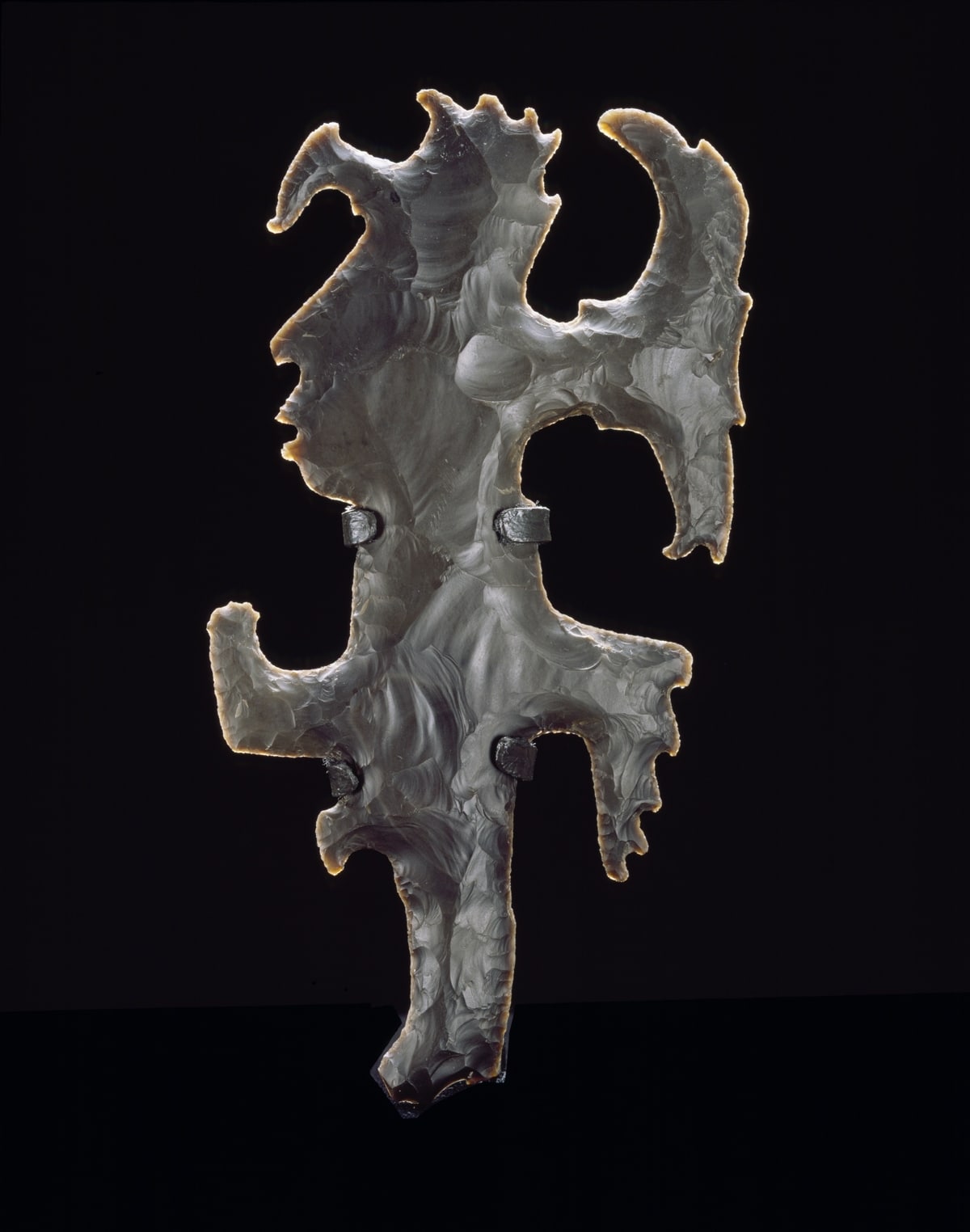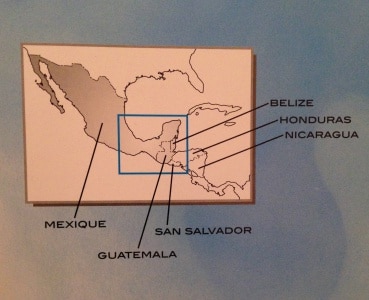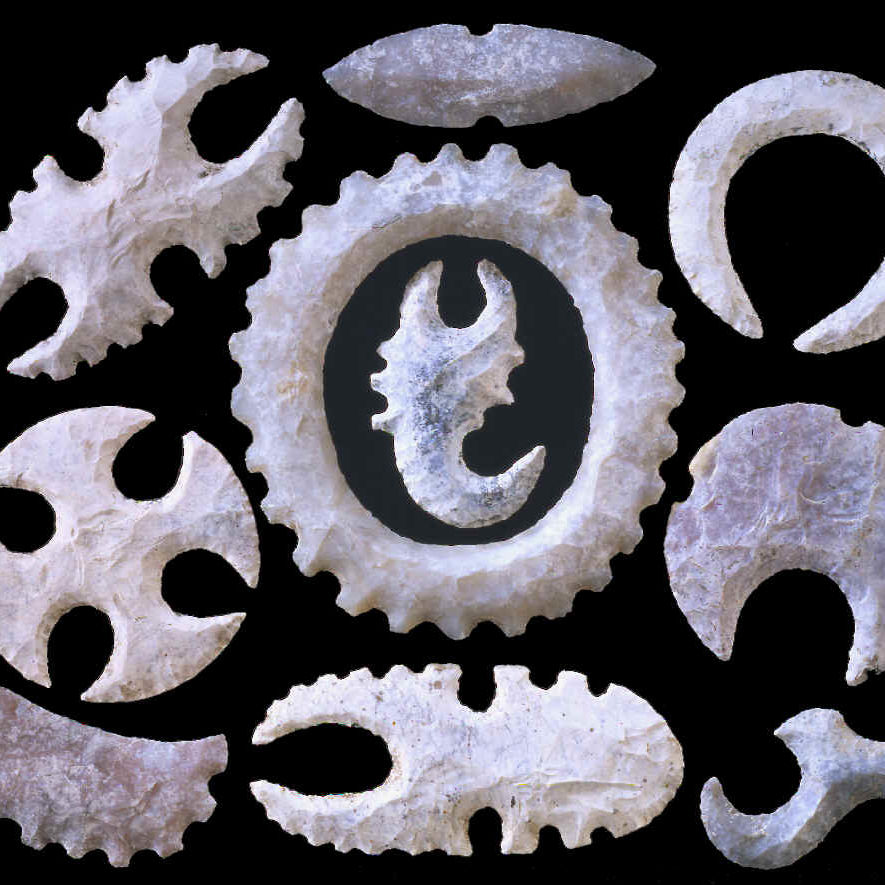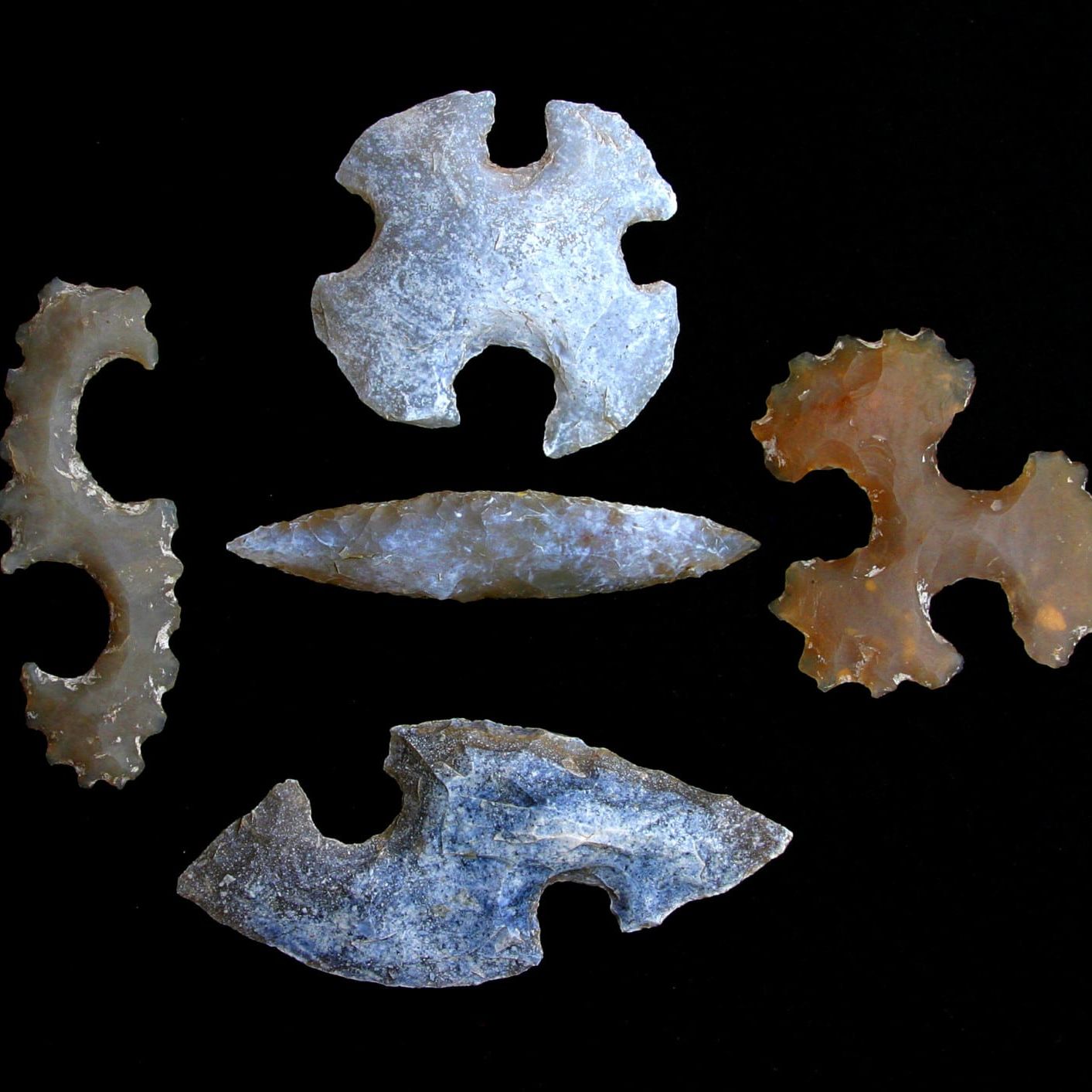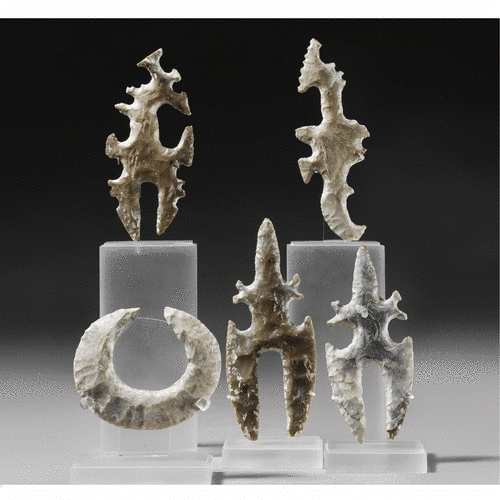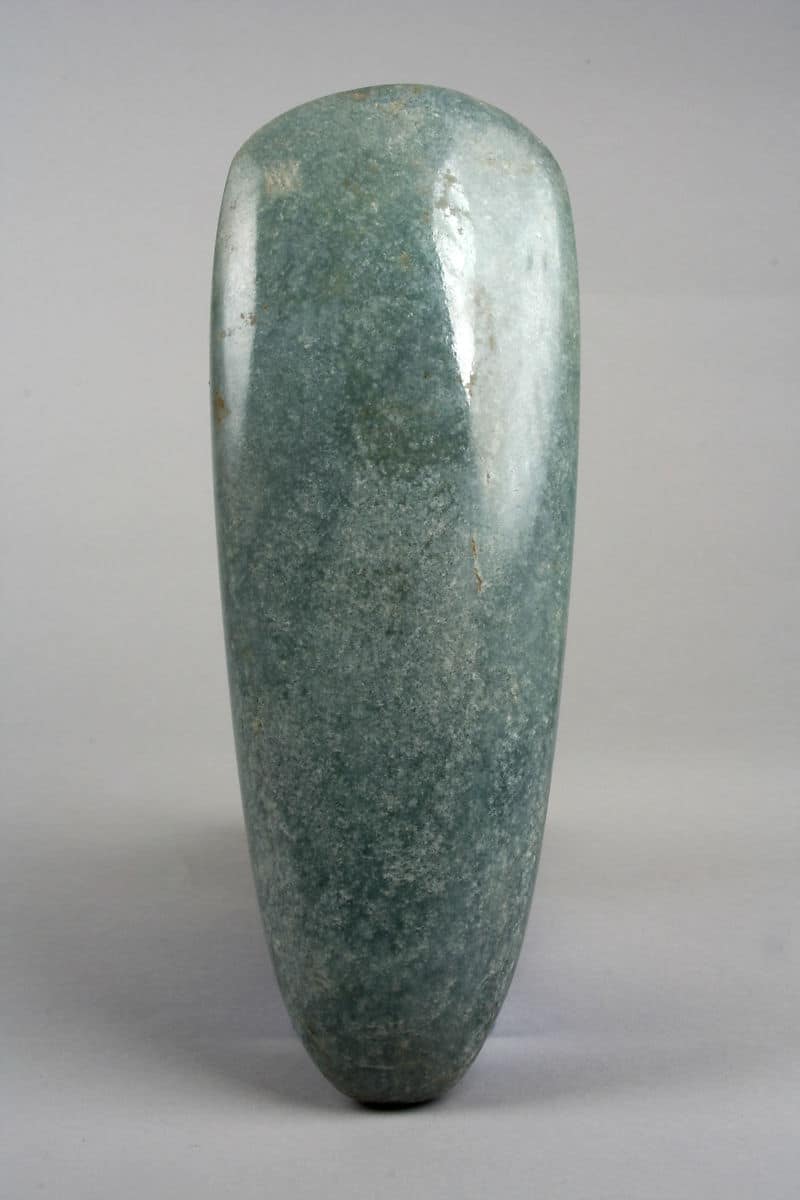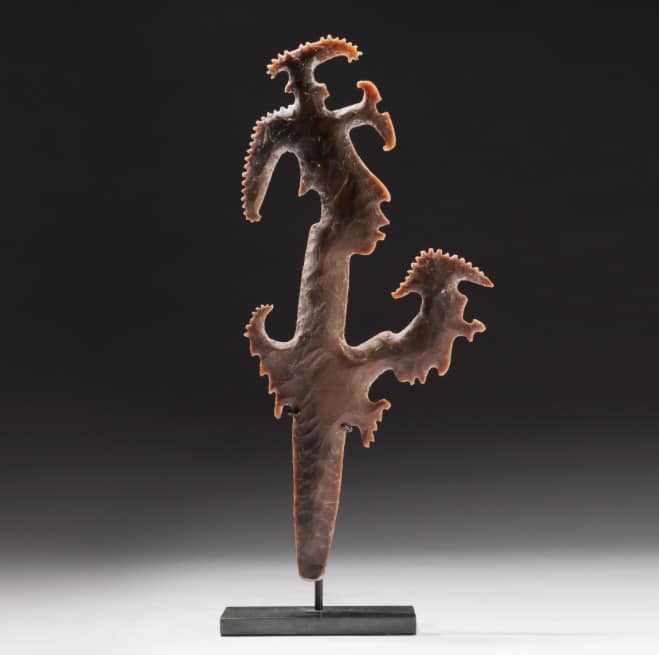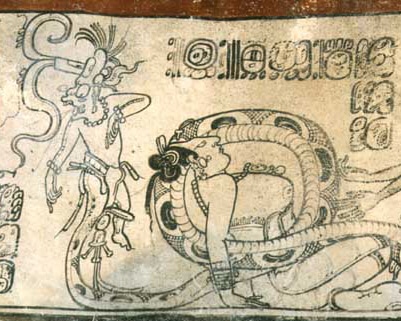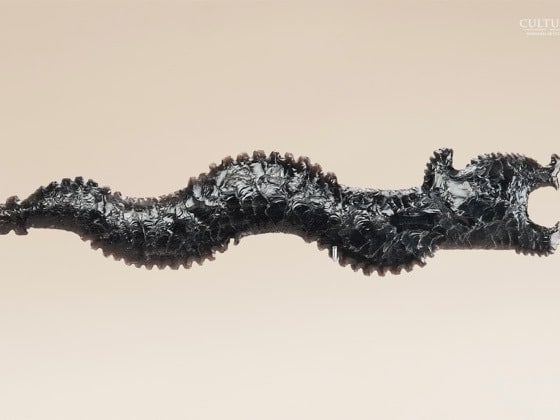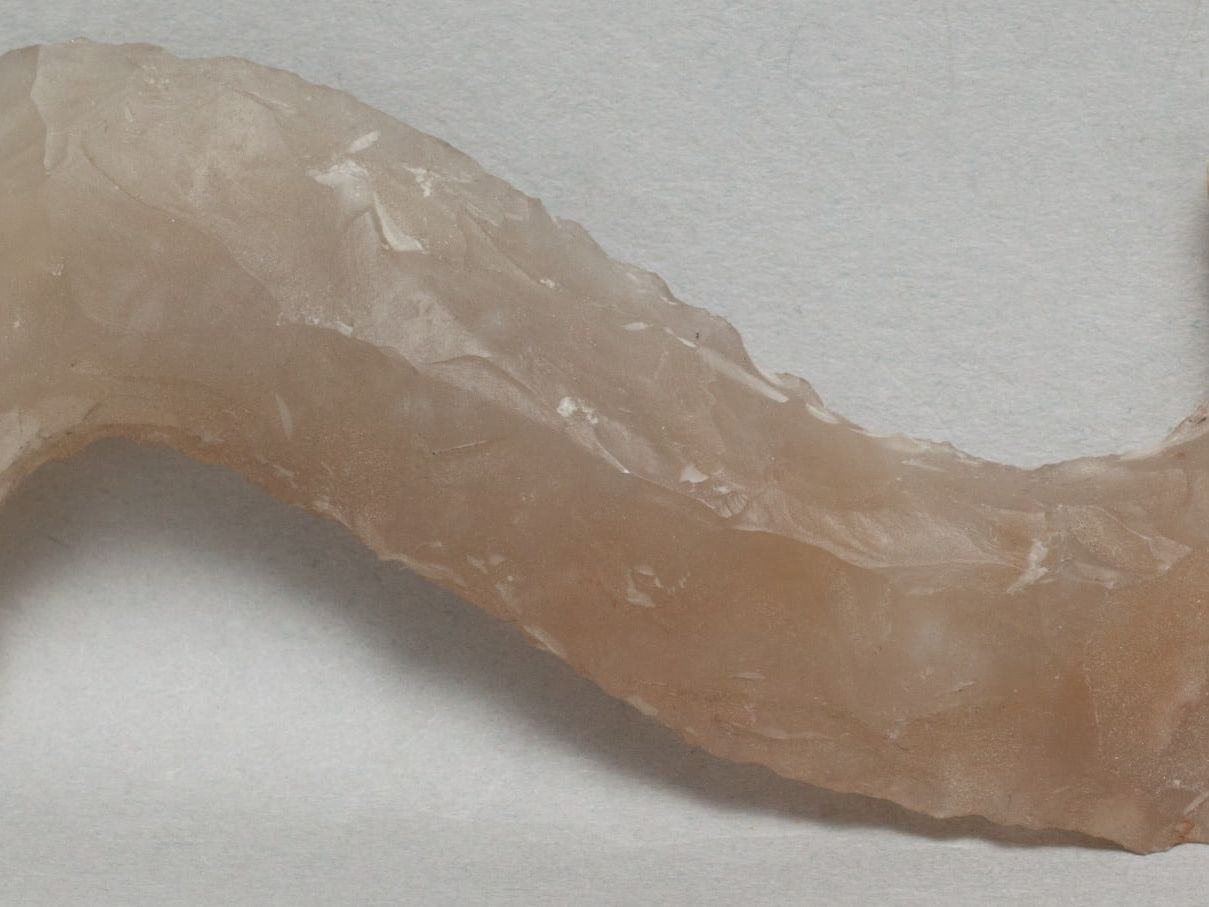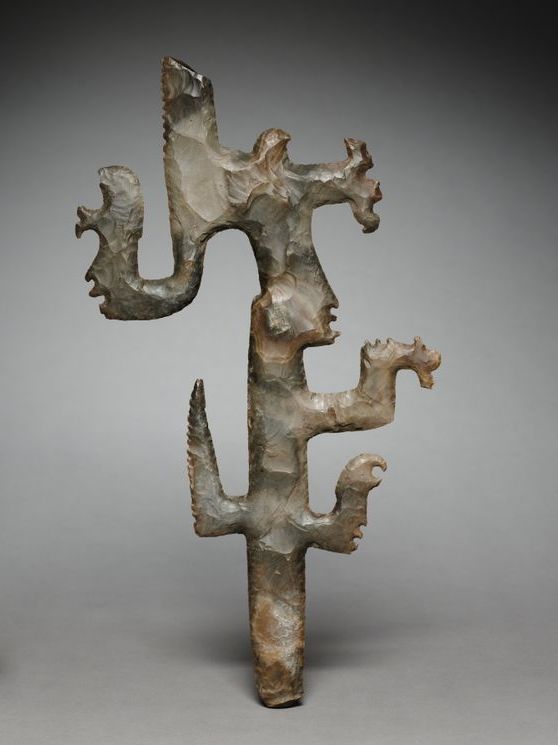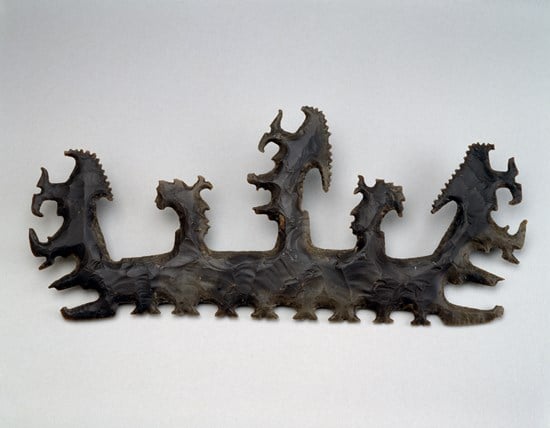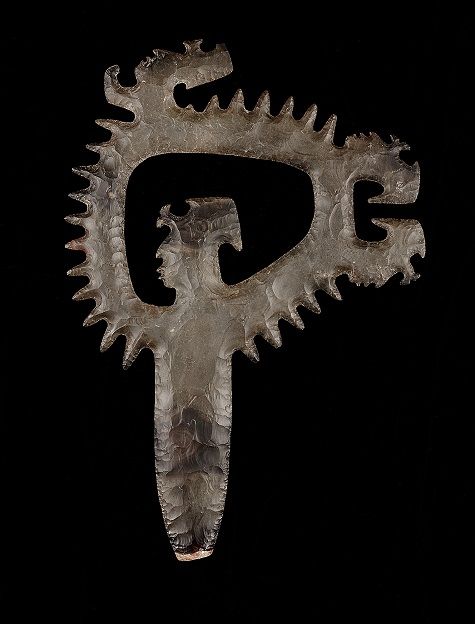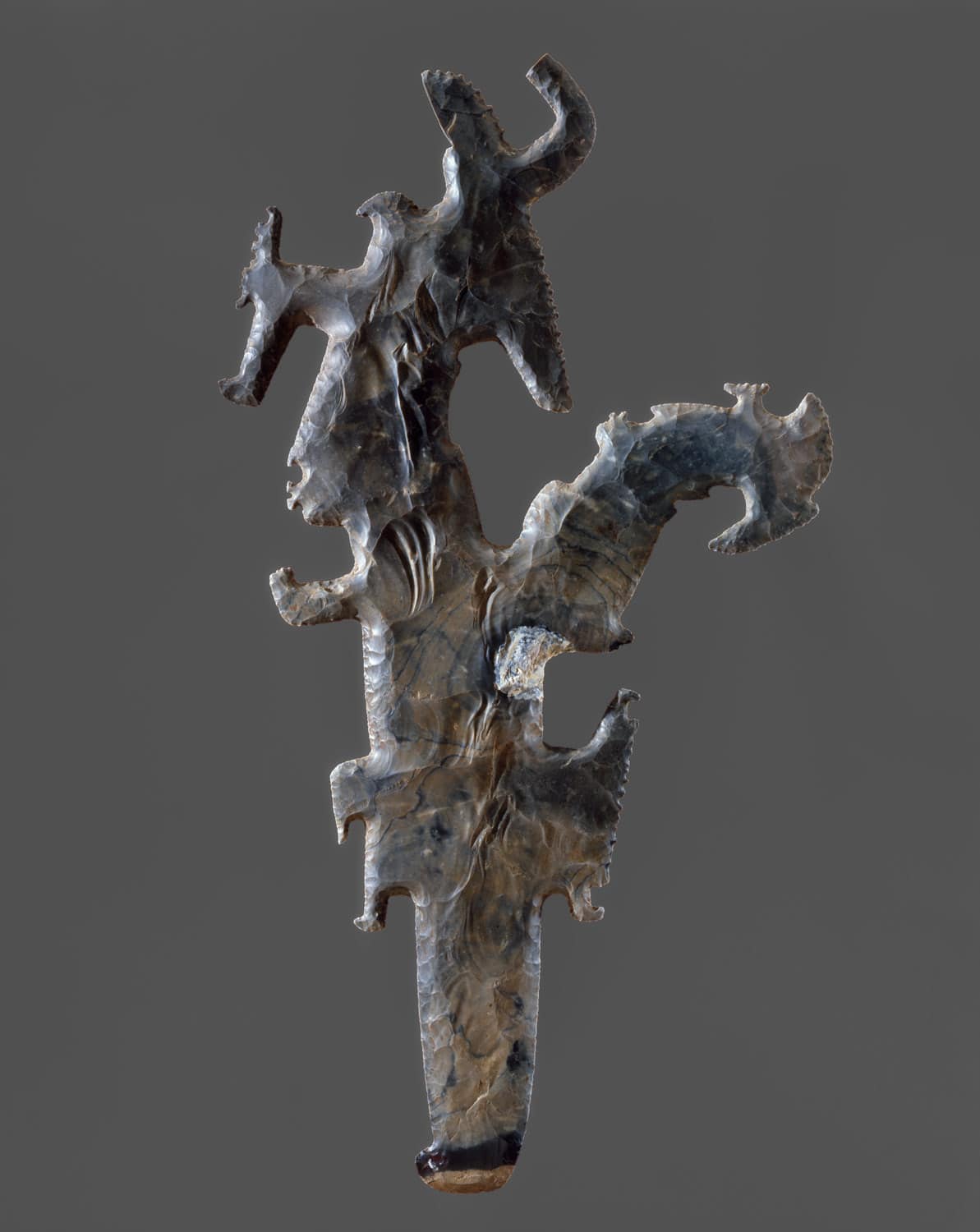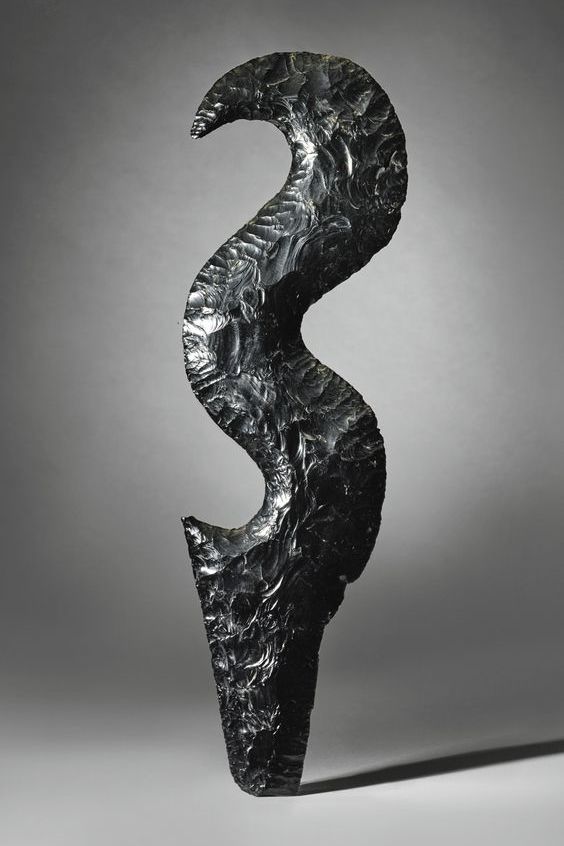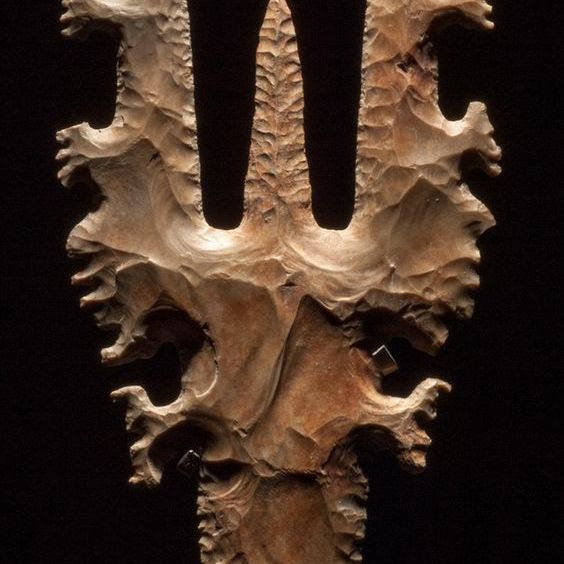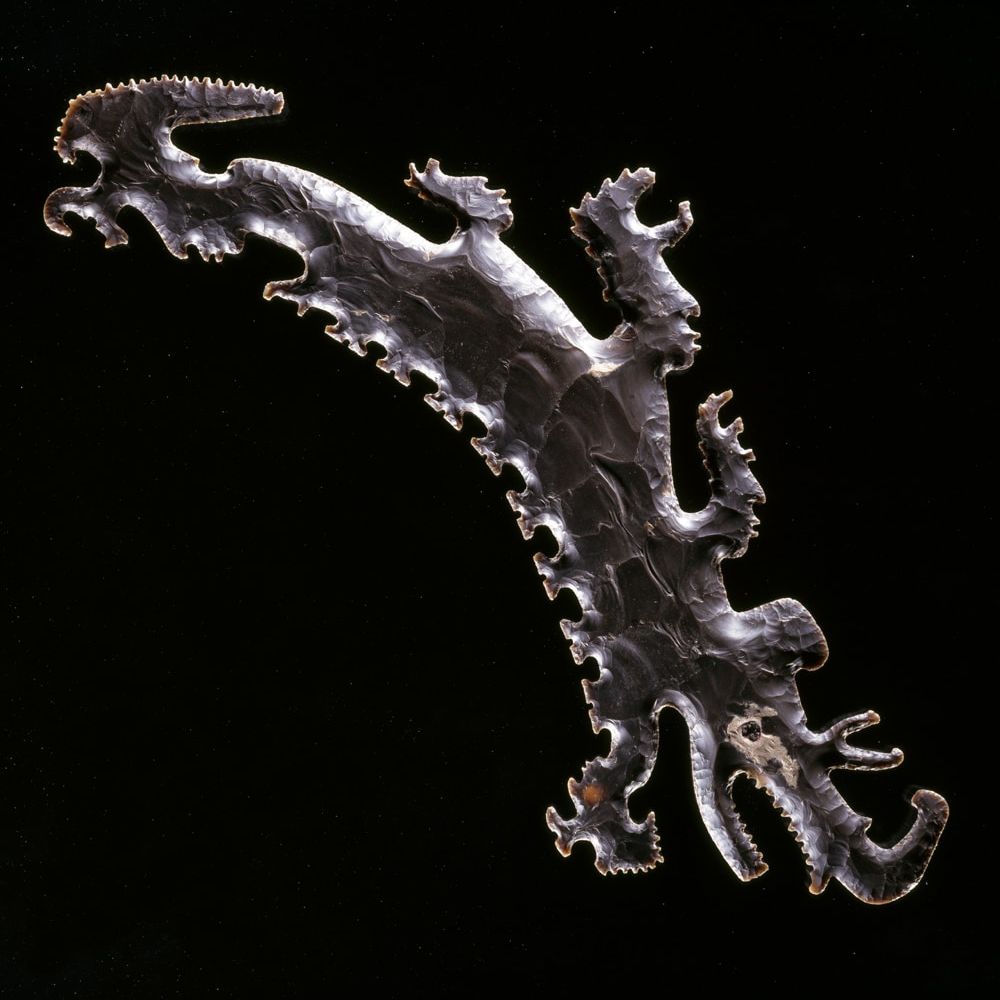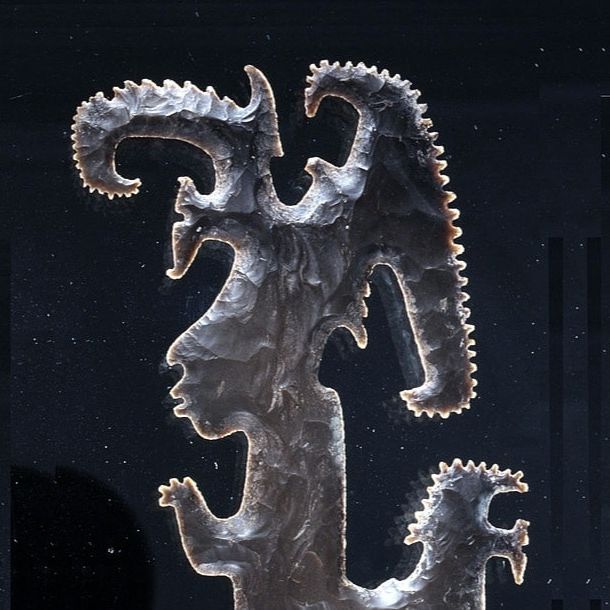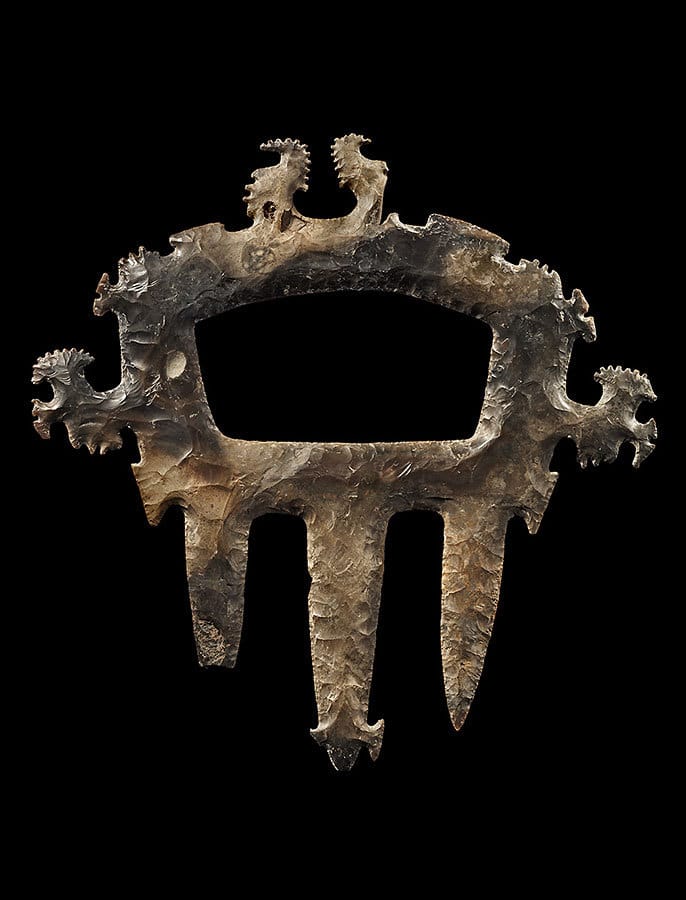Mayan obsidian eccentric flint blade shaped like a serpent, knapped between 550 AD to 950 AD
Although human sacrifices and other heartbreakings are not without evoking a certain fantasy of character, the term “eccentric” does not characterize the facetious Mayans here but many objects of which they were the authors, objects in obsidian or flint whose usefulness archaeologists and specialists are still struggling to understand.
Eccentric pre-Columbian Maya. Head of K’awiil. © Houston Museum of natural sciences
The Mayans for Dummies
First thing, the Maya occupied the land from around 2500 BCE to 1519 CE. The land in question extends from part of present-day Mexico to Guatemala, Belize, Honduras, El Salvador and parts of Nicaragua and Costa Rica.
Map taken from the book “The Mayas, treasures of an ancient civilization”. See bibliography.
Several periods (Preclassic, Classic and Postclassic) stylistically divide this long era from the origins of the Mayan civilization (with the Olmec culture in particular) to its fall marked by the arrival of the Spaniards. These charming travelers applied themselves to meticulously destroying the Mesoamerican cultures and in particular all that was in paper form, thus undermining the sources used to understand these civilizations. Diego de Landa (1524 – 1579), Spanish Franciscan monk, is curiously the best chronicler of the Mayan world but also a fanatical fanatic who compulsively tortured and endeavored to destroy the vestiges of Mayan culture with memorable burnings:
“We found them a great number of books written with these letters [ glyphs, the captivating Maya script ], and as there were none where there was no superstition and lies of the devil, we burned them all. which they felt wonderfully and gave them much grief. (Genet 1929:101)
“A lot of grief” ah bah you surprise me.
If the Hispanics were a real cultural shock (and not only cultural), it should be noted that this large territory brought together many populations with multiple cultures although based on a common base. Long before the Europeans landed, there were already differences within these spaces, although a common unity unites the Mesoamerican cultures. Thus, the economic, artistic and intellectual domains overlapped and the cults were all articulated around a common complex calendar.
The Maya civilization developed by drawing on the Olmec culture that preceded it. We have recently known that the first Mayas were contemporaries of the last Olmecs, which allowed fruitful exchanges in the field of self-sacrifice (a very nice legacy, then) but also in a lot of other fields such as the symbolic importance of ax blades closely associated with lightning.
Votive ax stone, Jade, 10th – 4th century BCE. Olmec culture. © MET Museum
Interesting detail of Olmec demiurgy (the “how the world was created” from the mythology of each civilization): the Olmecs conceived of the earth as being the monstrous form of a jaguar whose gaping mouth led to the underworld (world chthonic, dark and associated with the night).
This feline also served as an emblem of power and the reigning lineage. However, all the Mayan eccentrics have been found buried in caches, places linked to particular and non-domestic architectural structures, therefore linked to an “underground” and hidden world.
Mayan eccentrics are discovered in places arranged in direct relation with the underworld. They seem to directly evoke certain gods related to life and power.
Eccentric Maya sold on May 13, 2011 in New York (hammer price: $134,500). Flint. Maya Culture, Early Classic, ca. 550 – 950
© Sotheby’s
The (special) god K
Mayan eccentrics take many forms, but one is more common than the others. This particular shape will allow you to understand how these objects are closely linked to the Maya underworld.
Since 1897, the Mayan gods have been designated by letters. This system was proposed by Paul Schellhas (1859 – 1945), a pioneer of Mayan epigraphy who identified around thirty deities of this culture. The concordances between the gods identified by Schellhas and those quoted by this crazy Diego de Landa are still the subject of research. Nevertheless, some associations are beginning to stabilize.
Without further ado, here is the god K whose physiognomy is characterized in particular by a long and wide muzzle turned up vertically.
The German Eduard Seler (1849 – 1922), anthropologist, ethnologist, historian, linguist and epigraphist (#respect) thinks that this god is very close to the god of rain and associates him with the cultivation of a cereal (Special K , do you have it?): corn. The scholar therefore proposes to identify this god with Bolon Ts’akab or K’awiil . But K’awiil has specific attributes: a zoomorphic head with large eyes, an upturned muzzle, a sort of mirror, torch or ax coming out of his forehead and emitting smoke and a snake which takes the place of his only leg. even though the snake is usually considered to symbolize lightning.
Woman Embraced by the Serpent Foot of the God K. Justin Kerr: The Maya Vase Book. Flight. 6, Kerr Associates (2001). Classic Period
The glyphic writing of the Mayas is a figurative writing (I’ll make it short because it’s far from being so simple). The spelling for the god K’awiil usually includes a mirror glyph with wisps of smoke. So you can conclude that this is a very important characteristic of this god.
Other interpretations of the name K’awiil offer a reference to stone carvings, flints and axes associated with lightning or lightning (hello Olmecs). Scholars have also proposed an association of K’awiil with the word “obsidian” ( tah or toh ) thereby suggesting a connection with Tohil , the Quichean god of lightning, thunder and storm who was also the lord of an important lineage (the Quiché civilization is related to the Maya civilization and was present on the Guatemalan plateau. The Quiché people still exist today).
The name K’awiil was often incorporated into the personal names or titles of Maya chiefs. Add to this that the combined glyph meaning “the god K in the hand” refers to the designation or an advent of the heirs.
And that, my dear Watson, is a second characteristic of K’awiil : like Tohil , he is a royal god associated with ruling lineage and power.
Furthermore, if K’awiil ‘s form evolves over a period spanning more than 1,000 years, he invariably carries a smoking mirror. Finally, the single leg of this god is, as we have seen above, a serpent symbolizing lightning. However the serpent, like many other cultures, is a symbol of fertility and fecundity which seems related to lightning and this from the Olmec period.
Perhaps the linear form of lightning evoked in the eyes of these people a serpent? Anyway, lightning is synonymous with fertility – because it brings rain – and power because it strikes down enemies.
Obsidian serpent figure. Teotihuacan, (200-250), © Jorge Pérez de Lara Elías. INAH. Courtesy of the Fine Arts Museums of San Francisco.
[Click to enlarge] Flint eccentric in the shape of a snake. Between the 7th and 10th centuries. © Detroit Institute of Arts
Let’s sum up: K’awiil (or god K), identified as a deity of water (of rain more likely), is characterized by a mirror giving off wisps of smoke, a snake foot linked to lightning and an etymology referring to stone, flint and obsidian. This link with these materials refers by extension to lightning, thunder and storms. To top it off, the god is equated with royal power.
These first elements are reminiscent of the Miss Weather Channel (but ugly). Yet it is on the side of the Aztecs that we must turn. I said above that the Mesoamerican culture presented a unity – notably ritual – despite the extent of this territory. Here is an example.
The Aztecs who emerge at the very beginning of the 13th century rub shoulders with the Mayas; there are thus similarities between these two peoples, particularly in their cultural practices. Looking into the Aztec pantheon, we discover Tezcatlipoca whose name literally means… “smoking mirror”. And here are other well-attested characteristics of Tezcatlipoca: he is the most feared god of all Aztec deities, his association with the jaguar Tepeyollotlis no longer in doubt and the eyespots of the feline’s fur are often reproduced on the divine face evoking the starry night. He is therefore a god linked to the night, to royalty, to time, to wizards and to memory. Her attribute is the obsidian mirror which allows her to read the future and the hearts of men. At least one of his feet is finished with a snake.
The god Tezcatlipoca in the Borgia Codex.
The god’s qualities of omnipresence and omniscience were a metaphor for royal power that “knows everything”. This metaphor was embodied in the obsidian tezcatl mirror . The semantic proximity between the god Tezcatlipoca and the tezcatl stone object was so strong that obsidian was considered a manifestation of divinity.
Mayan eccentric in flint. Guatemala, Quirigua, between 600 and 900 CE. © Cleveland Museum of Art
Obsidian and flint are recurring in the attributes of the three Mesoamerican deities Olmec ( Tohil ), Maya (God K or K’awiil ) and Aztec ( Tezcatlipoca ). These are also the recurring materials of the eccentrics taking the form of the God K whose attribute is – remember – the smoking mirror just like the Aztec Tezcatlipoca .
And what will be your surprise when you learn that in Meso-American thought there is a symbolic equivalence between the mirror and… the cave, precisely these places where the eccentrics are hidden.
The Cave of Wonders
At the beginning of the 17th century, Ruiz de Alarćon y Mendoza (1581 – 1639) Spanish playwright born in Mexico collected incantations in which it is explained that the surface of the earth is like a “smoking mirror”. The name Tezcatlipoca literally means “smoking mirror”. It is also associated with the jaguar Tepeyollotl god of the mountains and the echo and whose etymology of the name means “heart of the mountain”.
If there is one thing in the heart of the mountain, it is the caverns, the caves and all those dark cavities where humans do not give a damn.
Being well informed about Tezcatlipoca, it is through him that I will go to shed light on the personality and symbolism of the god K (humbly following the example of the venerable researchers and academics whose work guided the writing of this article).
The patterns of swirls emerging from the Tezcatlipoca mirror naturally evoke swirls of smoke, but that’s without taking into account the important notion of versatility of the sign. The latter thus makes it possible to consider other interpretations for this reason. Remember one: the one who sees in these volutes the creative word or even the echo of which the jaguar Tepeyollotl is the god.
Tzercatlipoca drawn from the Codex Borbonicus. Surrounded in red, the smoking mirror
It seems a little capillo-tracted but not so much in reality. For the good and simple reason that people who study these mysterious cultures leave nothing to chance. In particular, they set up practical experiments which demonstrated that the location of certain sanctuaries coincides with areas where sound propagates in a particularly powerful way.
Guilhem Olivier (1962 – ) French historian professor and researcher at the National Autonomous University of Mexico proposes “that there is an equivalence between the noise returned by the echo (Tepeyollotl) and the smoke which emanates from the mirror of Tezcatlipoca . These two manifestations […] would be associated both with ideas of fertility (smoke and noise arouse rain) but also with the determination of destiny (the echo announces and the mirror reflects the destiny of mortals). »
Fertility and destiny are two notions closely linked to royalty in Mesoamerican cultures. Many representations show the cosmic role of the sovereign who links the world of men and the “heart of the mountain”, that is to say the world of the spirits where the deities of water and fertility reign. The sovereign is the mediator of forces and it is to him that men owe their well-being and the abundance of their harvests.
Mayan eccentric in flint with K’awiil figures. Circa 550 – 950 AD. © Bensozia
Tezcatlipoca therefore unites – via the jaguar Tepeyollotl with which it is associated – the surface of the earth (the smoking mirror) and its entrails (the heart of the mountain). The surface of the earth is the world of humans while the heart of the mountain seems to be that of the jaguar. Then think back to the gaping mouth of the jaguar that the Olmecs consider to be the gateway to the underworld, there is a link…
Like the Olmec jaguar, Tezcatlipoca carries the creator-destroyer ambivalence. It acts on life by allowing (or not) the communication of men with the chthonic gods of water and fertility via the cave / mirror equivalence. Because these elements are both a gateway to the underworld. Depending on whether or not Tezcatlipoca allows mediation between men (represented by their sovereign) and the deities of the underworld, Tezcatlipoca exercises a power of creator or destroyer of life.
So, if the links that unite the Olmec jaguar to the Aztec Tezcatlipoca are so strong, we must recognize the relationship between Tezcatlipoca, the Mayan K god, K’awiil , and the Olmec jaguar. If so, that makes sense.
One can wonder about the function of the Maya eccentrics in the form of god K found in the caches. Were they intended to symbolize the presence of the god? Did they make it possible to bind a possible possessor of the eccentric to the divinity or to attribute to him a little of the power of the god? So many questions to which I have no answer (haha).
Thunderbolt
The materials used for the eccentrics in the Classic period were not chosen at random. The obsidian and flint used for the K-shaped god eccentrics were valuable materials in both domestic and spiritual life.
K’awiil figure eccentric used as a scepter figure. Cira 7th – 8th century CE. Maya civilization, Guatemala. © MET Museum
Obsidian in particular had a special status since it was a rock imported from Guatemala, therefore an expensive material.
Obsidian is a glassy volcanic rock which, once cut, produces very sharp edges. She was particularly valued for the aristocratic practices of self-sacrifice. No, the guys didn’t sacrifice themselves to death. They were content to pierce themselves or to shed blood in strategic places where the first comer would oppose a categorical refusal to this kind of practice. Example: the genitals. Obsidian obviously had a reputation for cutting cleanly, opening wounds which then had less of a tendency to become infected (we wish them).
Mayan eccentric in obsidian in the stylized form of a serpent. Early classic, cira 550 – 950 CE
Some researchers maintain that obsidian was considered a type of blood from the earth. In this case, its filiation with the god K aka K’awiil aka Tzercatlipoca aka the Olmec jaguar would be natural: if obsidian is the blood of the earth, then it is the blood of the god K since he is the earth (d as obsidian was considered by the Aztecs as a manifestation of Tzercatlipoca ).
It has been suggested that the Mayans believed that flint was the result of the clash between lightning and the earth’s surface, giving this material supernatural power. However, the serpent which serves as the sole leg of the god K but also of Tzercatlipoca precisely symbolizes lightning. Then the flint could be a manifestation of the God K as is the obsidian of Tzercatlipoca .
K-shaped god eccentrics could thus symbolize the god or store the fertilizing “charge” of lightning within them.
Flint eccentric from the Classic Maya period
Once deposited in dedicatory caches strategically placed in the center of an architectural structure, the obsidian and flint eccentrics could have been understood as the manifestation of the god K in the “heart of the mountain” (remember the jaguar equivalent of the divinity). The fruitful charge contained in the stone would then take on its full meaning since the heart of the mountain is the territory of the underworld, the place where the deities of water and fertility reign.
The link between sky (lightning) and earth (fecundity), between creation and destruction, personified by the god K, K’awiil , Tzercatlipoca and the Olmec jaguar would thus be summed up in the eccentric: it would be the fruitful charge of the lightning that combines with the deities of the fertility of the earth to give life.
The debate remains open. The eccentrics in obsidian or flint in the form of the K god nonetheless remain objects resulting from a complex know-how. Our modern tailors are still not able to reproduce Mayan creations with the same finesse and the same tools. Few public collections in the world will allow you to admire Mayan eccentrics of the god K, but other forms of eccentrics exist and the Musée du quai Branly in Paris offers two fine examples from the classical period.
Related Post
A shocking documentary proves that mermaids do exist
SHOCKING Revelation: Thuya, Mother of Queen Tiye, Was the Grandmother of Akhenaten and Tutankhamun—What Ancient Egyptian Secrets Did She Leave Behind?
Breaking News: Astonishing Discoveries at Karahan Tepe Confirm an Extraterrestrial Civilization is Hiding on Earth, and NO ONE Knows!
Breaking News: Researchers FINALLY Discover U.S. Navy Flight 19 After 75 Years Lost in the Bermuda Triangle!
NASA’s Secret Investigation: Uncovering the Astonishing Mystery of the UFO Crash on the Mountain!
Explosive UFO Docs LEAKED: Startling Proof That Aliens Ruled Ancient Egypt!
